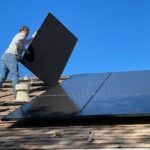 Public awareness of climate change has seldom been greater, with the summer of 2022 seeing heat waves and droughts across Europe. In the United States, investments in green infrastructure represent a considerable portion of President Biden’s stimulus package. This is reflected in Europe, with the European Commission arguing that up to 290 billion euros per year will be needed to develop green energy and infrastructure.
Public awareness of climate change has seldom been greater, with the summer of 2022 seeing heat waves and droughts across Europe. In the United States, investments in green infrastructure represent a considerable portion of President Biden’s stimulus package. This is reflected in Europe, with the European Commission arguing that up to 290 billion euros per year will be needed to develop green energy and infrastructure.
Research from EDHEC Business School suggests that such investments would provide a good return, even when compared to investments in fossil-energy infrastructure.
Good returns
The researchers assessed the performance of investments in both green and dirty energy infrastructure between 2011 and 2021. They found that over the 10-year period, the return on wind and solar energy projects was 16%, versus 17% for fossil energy projects.
While this suggests the returns are similar, the researchers believe this doesn’t present the entire picture. Indeed, with changing investor preferences for green projects, there tends to be an excess demand for such investments, which contributes to better performance in comparison with more conventional assets.
The researchers explain that green investments totaled over $225 billion in the first half of 2022, which represents a growth of 11% on the same period in 2021. There was particular enthusiasm for solar and wind projects, which grew by 33% and 16% respectively. Indeed, the Economist recently argued that the North Sea could become an economic powerhouse, in large part due to the large amount of wind energy developed in the region.
Shifting focus
This is in stark contrast to the fortunes of fossil fuel investments, which represented just 1-3% of investment portfolios during 2022. The declining popularity of fossil-fuel investments is largely linked to the expectation of rising environmental taxes. Indeed, in 2020, investment in renewables surpassed those made in oil and gas production for the first time.
While green investments may well have peaked in terms of the return one can expect from them, that should not mean that they represent a bad investment, especially compared to investments in fossil fuels.
There is therefore no real risk premium for green infrastructure projects that investors could benefit from over the long term. In fact, we should rather speak of a “green premium”, which investors were willing to pay at a given moment, when responsible assets gained in popularity. The outperformance of green assets over the previous decade was only due to excess demand, which eventually diminished.
In other words, when supply finally caught up with demand, green assets experienced a relative decline in performance as a result of a return to market equilibrium. The green premium is a reality, but it was only meant to be temporary. The previous decade should therefore be seen as a transition period, not as the beginning of a permanent phenomenon.